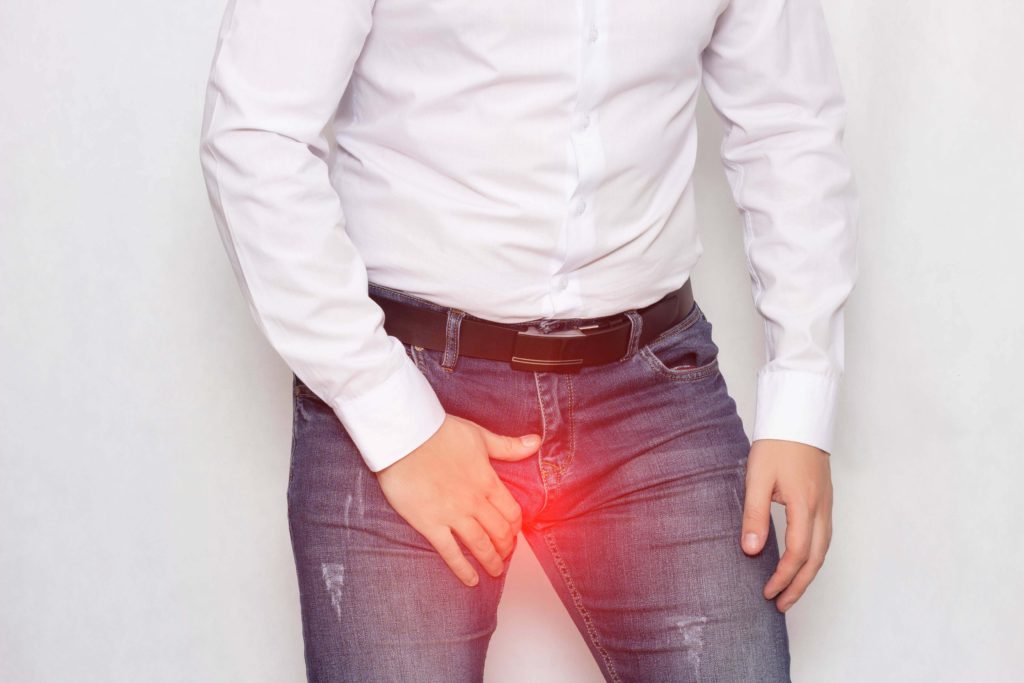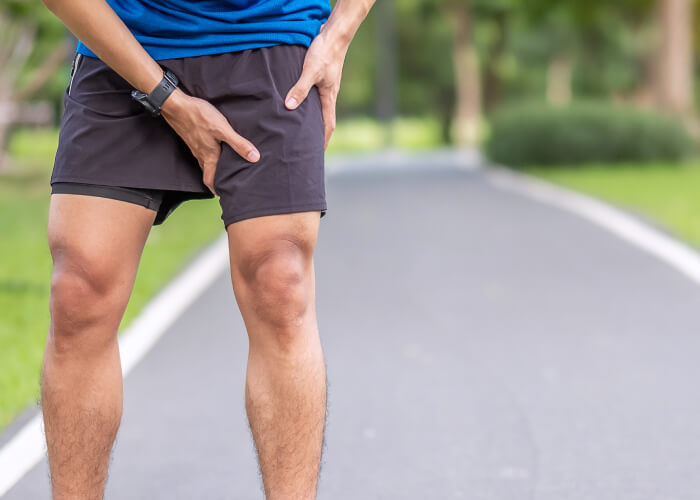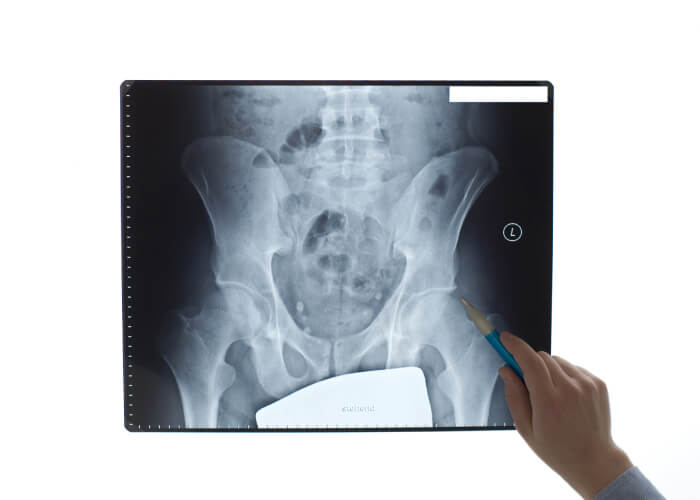
Groin pain is any pain or discomfort in the groin region, which is located in the lower abdomen region— where the abdomen ends and the legs (inner thighs) begin.
Often, groin pain occurs from an injury or strain in the muscle-tendon unit of the groin, which is common in Athletes or people who engage in sports such as basketball, football, rugby, running.
Depending upon the specific cause, the groin pain can be acute or chronic.
The groin is a complex region that consists of muscles, ligaments, tendons and fascia that attach to the pubic bone. It has three large groups of muscles, the abdominal, iliopsoas and adductor muscle groups and ligaments, including the inguinal, lacunar and pectineal ligaments.
Typically, groin pain in sporty people arises from a tear in the abdominal or adductor muscles.
Pain in the groin can also be due to Hip Joint pain from Arthritis, Trauma, Pregnancy (symphysis pubic dysfunction) or from referred pain from the lower back. In certain people, groin pain can also be due to a hernia.
Symptoms of Groin Pain
Groin pain is usually a dull ache in the groin/pubic region, including the inner thigh and front of the hip. However, it can also become an excruciating or burning pain in certain positions. You should visit a doctor urgently if you experience sudden onset groin pain whether it occurs spontaneously or due to an injury.

Some of the most common features of groin pain are:
- Pain, stiffness or tenderness in the groin and inner thigh
- Pain while raising your legs or bringing your legs together
- Pain in the groin while lifting or coughing
- A snapping sound in the groin at the time of injury
- Stiffness or decreased range of motion in the hip
Causes of Groin Pain
– Sports
Groin pain in Sports can often be due to a Muscle strain or a microtear in muscles or tendons. A pulled muscle (Adductor muscle group), tendon or ligament in the inner thigh may cause injury or pain in the groin. Groin pain often affects Athletes in high-impact sports like basketball, soccer and running.

What these sports have in common is movements which may involve sudden changes in direction or speed. This can cause ‘shearing’ forces on the muscles and tendons in the groin region or lower qbdominal area.
Groin pain can also be due to referred pain from the lower back. A lumbar disc herniation can also cause referred pain in the groin area. This may be due to a disc herniation causing stress on the lower back ligaments such as the iliolumbar ligaments
Some of the other common causes of groin pain are:
- Hip osteoarthritis
- Inguinal hernia
- Sports hernia (Gilmores Groin)
- Femoroacetabular impingement
- Hip adductor tendinopathy
- Trapped Nerve
- Bursitis
- Hip labrum tear
- Lower Back Referred Pain
Groin pain may also be a symptom of testicular, abdominal or pelvic conditions. Though these conditions are serious and need immediate medical attention— they usually are a less common cause of groin pain. The causes include:
- Intestinal inflammation
- Testicular inflammation
- Testicular torsion
- Inflammation of epididymis
- Ovarian cysts
- Pregnancy (Symphysis pubic dysfunction)
- Urinary tract infections
- Kidney stones
- Infected hip joints
- Synovitis
- Tumour
Diagnosis of Groin Pain
Due to the complex anatomy of the groin, your doctor will use a comprehensive diagnostic process to diagnose the accurate cause of your groin pain. This starts with a detailed review of your medical history and a physical examination. The Doctor will ask you to sit, walk or lie on your hip to evaluate the range of motion, strength, hip flexion and balance.
Your doctor may perform the FADDIR test (flexion, abduction, and internal rotation), or a Trendelenburg test to rule out other causes. The doctor may also ask for imaging tests like X-rays, MRIs or ultrasounds to diagnose the exact cause of groin pain.

Sometimes, the doctor may also ask for blood tests to determine if there is an infection.
Treatment for Groin Pain
The treatment for groin pain usually begins by resting and treating the affected area with ice packs or heat. However, if the symptoms do not improve with home treatments, you need to visit a doctor for a proper medical diagnosis and treatment.
Analgesics
Groin pain and inflammation can be relieved by using several non-steroidal anti-inflammatory drugs such as Ibuprofen or Naproxen
Injections
Cortisone injections also help reduce the swelling and pain from the injury or tear in the groin area. Depending upon your symptoms, your doctor will increase or decrease the number of shots per week. Cortisone injections are useful for conditions such as Symphisis Pubis Dysfunction.
Physical Therapy
Physical therapy exercises and stretches help improve muscle strength and reduce groin pain. Our Osteopath can provide a specific treatment plan to promote fast healing and improved function at each stage of recovery.
Prolotherapy
This is a great option for Hip Osteoarthritis or labral tears. We use Prolotherapy at our Burnley Clinic and Manchester Clinic to treat Hip Osteoarthritis and Hip Labral tears. It is also an option in recurrent pain from Symphisis Pubis Dysfunction
Surgery
Surgery is an option to treat groin pain if there is a complete muscle tear, hip labral tear, testicular torsion, hernia.
Final Thoughts
Though groin pain often occurs from a muscle injury, it can also occur due to various other causes related to the hip joints and even lower back pain from herniated lumbar discs.
An accurate diagnosis and treatment plan is therefore essential in treating groin pain.
When engaging in sporting activity, you can also take a few steps to prevent groin pain or help existing groin pain.
- Gently warm up before exercising, lifting or playing a high-impact sport
- Muscle strengthening exercises
- Maintain a healthy weight
- Increase the intensity of your workout slowly
- Make sure to cool down after the workout
FAQ’s
I’m a runner, Why am I getting groin pain?
Groin pain is the result of any injury, pull or strain in the muscle, ligament or tendons in the groin area. It usually is an athletic injury caused by overusing or straining the muscle group where the abdomen and upper thigh meet.
Should I worry about my groin pain?
Groin pain is not something to worry about in most cases. However, if you experience severe, recurring pain, you must seek medical attention immediately. Also, get immediate medical help if your groin pain accompanies fever, diarrhoea, vomiting, blood in the urine or discomfort in walking.
How do I know if my groin pain is due to an inguinal hernia?
If your groin pain is due to an inguinal hernia, you will feel a bulge or lump in the groin area that’s sometimes visible and tender to the touch. You may also experience pain or a tugging sensation in the groin area when straining your abdomen in activities such as lifting. However, groin pain from an inguinal hernia can also occur without showing symptoms.
Can a herniated disc cause groin pain?
Yes, your groin pain can be a symptom of a herniated disc. Most people with lumbar disc herniation get groin pain because of the compressed nerves travelling through the groin region. The additional stress on the ligaments in the lower back can also cause referred pain to the groin.
Is my groin pain due to symphysis pubic dysfunction?
When you are pregnant, your groin pain can be due to symphysis pubic dysfunction. When the ligaments that keep the pelvic bones aligned become too stretchy or relaxed, it adds pressure on the pubic joint, causing pain that is felt in the pubic/groin region. In general, groin pain associated with symphysis pubic dysfunction goes away within six months post-pregnancy. If it doesn’t, you must consult your GP.
Can I get Injections for Groin Pain in Manchester?
Yes. At MyMSK Clinic we offer Ultrasound guided Cortisone injections and also prolotherapy treatment in our Deansgate, Manchester Clinic. To arrange a consultation with our experienced clinician please visit our Booking Page or call us at 0333 772 9655.




